Related Research Articles

The Silurian Shawangunk Formation is a mapped bedrock unit in eastern Pennsylvania, New Jersey, and New York. It is named for the Shawangunk Ridge for which it is the dominant rock type. The division of the Shawangunk between the Tuscarora Formation and Clinton Group has not been conclusively determined. The shift of nomenclature currently has the divide between Hawk Mountain and Lehigh Gap.

The Silurian Bloomsburg Formation is a mapped bedrock unit in Pennsylvania, New Jersey, New York and Maryland. It is named for the town of Bloomsburg, Pennsylvania in which it was first described. The Bloomsburg marked the first occurrence of red sedimentary rocks in the Appalachian Basin.
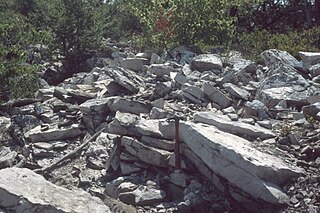
The Silurian Tuscarora Formation — also known as Tuscarora Sandstone or Tuscarora Quartzite — is a mapped bedrock unit in Pennsylvania, Maryland, West Virginia, and Virginia, USA.

The Ordovician Juniata Formation is a mapped bedrock unit in Pennsylvania and Maryland. It is a relative slope-former occurring between the two prominent ridge-forming sandstone units: the Tuscarora Formation and the Bald Eagle Formation in the Appalachian Mountains.

The Ordovician Reedsville Formation is a mapped surficial bedrock unit in Pennsylvania, Maryland, Virginia, West Virginia, and Tennessee, that extends into the subsurface of Ohio. This rock is a slope-former adjacent to the prominent ridge-forming Bald Eagle sandstone unit in the Appalachian Mountains. It is often abbreviated Or on geologic maps.

The Clinton Group is a mapped unit of sedimentary rock found throughout eastern North America. The interval was first defined by the geologist Lardner Vanuxem, who derived the name from the village of Clinton in Oneida County, New York where several well exposed outcrops of these strata can be found. The Clinton Group and its lateral equivalents extend throughout much of the Appalachian Foreland Basin, a major structural and depositional province extending from New York to Alabama. The term has been employed in Kentucky, Maryland, Michigan, New York, Ohio, Pennsylvania, Tennessee, Virginia, and West Virginia, though in many of these areas the same interval is referred to as the Rose Hill, Rockwood, or Red Mountain Formations. Historically the term "Clinton" has also been assigned to several lower Silurian stratigraphic units in Ohio and Kentucky which are now known to be significantly older than the Clinton Group as it was originally defined. Many parts of this succession are richly fossiliferous, making the Clinton Group an important record of marine life during the early Silurian. Several economically valuable rock-types are found within this interval, though it is perhaps best known as a significant source of iron ore

Wills Creek Formation is a mapped Silurian bedrock unit in Pennsylvania, Maryland, Virginia, and West Virginia.

The Devonian Hamilton Group is a mapped bedrock unit in the United States. The unit is present in New York, Pennsylvania, Maryland, Ohio and West Virginia. In Virginia, it is known as the laterally equivalent Millboro Shale. The group is named for the village of Hamilton, New York. Details of stratigraphic nomenclature for this unit as used by the U.S. Geological Survey are available on-line from the National Geologic Map Database. These rocks are the oldest strata of the Devonian gas shale sequence.
The Devonian Mahantango Formation is a mapped bedrock unit in Pennsylvania, West Virginia, and Maryland. It is named for the North branch of the Mahantango Creek in Perry and Juniata counties in Pennsylvania. It is a member of the Hamilton Group, along with the underlying the Marcellus Formation Shale. South of Tuscarora Mountain in south central Pennsylvania, the lower members of this unit were also mapped as the Montebello Formation. Details of the type section and of stratigraphic nomenclature for this unit as used by the U.S. Geological Survey are available on-line at the National Geologic Map Database.
The Mississippian Mauch Chunk Formation (Mmc) is a mapped bedrock unit in Pennsylvania, Maryland, and West Virginia. It is named for the township of Mauch Chunk, now known as borough of Jim Thorpe, Pennsylvania and for nearby Mauch Chunk Ridge where the formation outcrops.
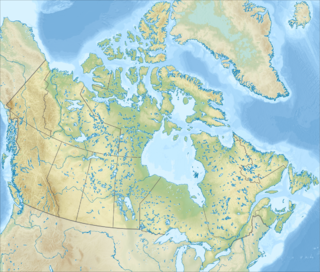
The Muskwa Formation is a stratigraphical unit of Frasnian age in the Western Canadian Sedimentary Basin.

The Smoky Group is a stratigraphical unit of Late Cretaceous age in the Western Canadian Sedimentary Basin.
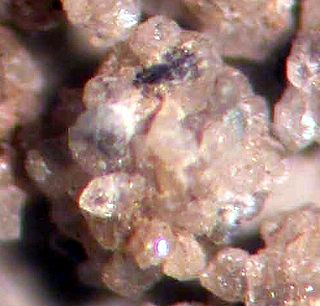
The Dunvegan Formation is a stratigraphical unit of Cenomanian age in the Western Canadian Sedimentary Basin.
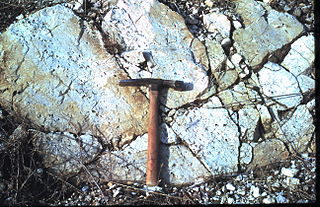
The Devonian Old Port Formation is a mapped bedrock unit in Pennsylvania, USA. Details of the type section and of stratigraphic nomenclature for this unit as used by the U.S. Geological Survey are available on-line at the National Geologic Map Database. Current nomenclature usage by U.S. Geological Survey restricts the name Old Port Formation to Pennsylvania, but correlative units are present in adjacent states.
The Triassic Stockton Formation is a mapped bedrock unit in Pennsylvania, New Jersey, and New York. It is named after Stockton, New Jersey, where it was first described. It is laterally equivalent to the New Oxford Formation in the Gettysburg Basin of Pennsylvania and Maryland.
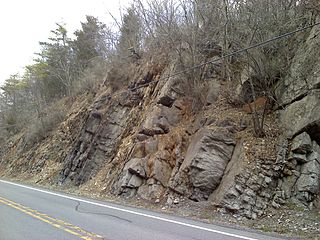
The Late Silurian to Early Devonian Keyser Formation is a mapped limestone bedrock unit in Pennsylvania, Maryland, Virginia, and West Virginia.
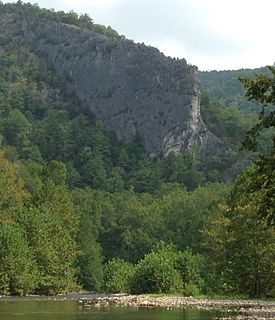
The Late Silurian Tonoloway Formation is a mapped limestone bedrock unit in Pennsylvania, Maryland, Virginia and West Virginia.
The Devonian Needmore Formation or Needmore Shale is a mapped bedrock unit in Pennsylvania, Maryland, Virginia, and West Virginia.
The Gettysburg Formation is a mapped bedrock unit consisting primarily of sandstones, conglomerates, and shales.

The Bertie Formation, also called Bertie Limestone and Bertie Dolomite, formerly named as Bertie Group, is a Late Silurian geologic formation and Lagerstätte in southern Ontario, Canada and western New York State, United States. The formation comprises dolomites, limestones and shales and reaches a thickness of 495 feet (151 m) in the subsurface, while in outcrop the formation can be 60 feet (18 m) thick.
References
- ↑ Paleozoic Sedimentary Successions of the Virginia Valley & Ridge and Plateau
- 1 2 3 "Geologic Maps of Maryland:" . Retrieved 2008-01-26.
| This article about a specific stratigraphic formation in Maryland is a stub. You can help Wikipedia by expanding it. |